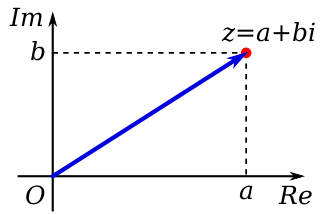
Complex analysis, traditionally known as the theory of functions of a complex variable, is the branch of mathematical analysis that investigates functions of complex numbers. It is helpful in many branches of mathematics, including algebraic geometry, number theory, analytic combinatorics, applied mathematics; as well as in physics, including the branches of hydrodynamics, thermodynamics, and particularly quantum mechanics. By extension, use of complex analysis also has applications in engineering fields such as nuclear, aerospace, mechanical and electrical engineering.

In mathematics, a complex number is an element of a number system that extends the real numbers with a specific element denoted i, called the imaginary unit and satisfying the equation ; every complex number can be expressed in the form , where a and b are real numbers. Because no real number satisfies the above equation, i was called an imaginary number by René Descartes. For the complex number , a is called the real part, and b is called the imaginary part. The set of complex numbers is denoted by either of the symbols or C. Despite the historical nomenclature "imaginary", complex numbers are regarded in the mathematical sciences as just as "real" as the real numbers and are fundamental in many aspects of the scientific description of the natural world.

Euler's formula, named after Leonhard Euler, is a mathematical formula in complex analysis that establishes the fundamental relationship between the trigonometric functions and the complex exponential function. Euler's formula states that for any real number x:
The Hahn–Banach theorem is a central tool in functional analysis. It allows the extension of bounded linear functionals defined on a subspace of some vector space to the whole space, and it also shows that there are "enough" continuous linear functionals defined on every normed vector space to make the study of the dual space "interesting". Another version of the Hahn–Banach theorem is known as the Hahn–Banach separation theorem or the hyperplane separation theorem, and has numerous uses in convex geometry.

In mathematics, mathematical physics and the theory of stochastic processes, a harmonic function is a twice continuously differentiable function where U is an open subset of that satisfies Laplace's equation, that is,

In complex analysis, the residue theorem, sometimes called Cauchy's residue theorem, is a powerful tool to evaluate line integrals of analytic functions over closed curves; it can often be used to compute real integrals and infinite series as well. It generalizes the Cauchy integral theorem and Cauchy's integral formula. From a geometrical perspective, it can be seen as a special case of the generalized Stokes' theorem.
In complex analysis, a branch of mathematics, analytic continuation is a technique to extend the domain of definition of a given analytic function. Analytic continuation often succeeds in defining further values of a function, for example in a new region where an infinite series representation in terms of which it is initially defined becomes divergent.

In mathematics, complex geometry is the study of geometric structures and constructions arising out of, or described by, the complex numbers. In particular, complex geometry is concerned with the study of spaces such as complex manifolds and complex algebraic varieties, functions of several complex variables, and holomorphic constructions such as holomorphic vector bundles and coherent sheaves. Application of transcendental methods to algebraic geometry falls in this category, together with more geometric aspects of complex analysis.
In complex analysis, Liouville's theorem, named after Joseph Liouville, states that every bounded entire function must be constant. That is, every holomorphic function for which there exists a positive number such that for all in is constant. Equivalently, non-constant holomorphic functions on have unbounded images.
In mathematics and signal processing, the Hilbert transform is a specific singular integral that takes a function, u(t) of a real variable and produces another function of a real variable H(u)(t). The Hilbert transform is given by the Cauchy principal value of the convolution with the function (see § Definition). The Hilbert transform has a particularly simple representation in the frequency domain: It imparts a phase shift of ±90° (π⁄2 radians) to every frequency component of a function, the sign of the shift depending on the sign of the frequency (see § Relationship with the Fourier transform). The Hilbert transform is important in signal processing, where it is a component of the analytic representation of a real-valued signal u(t). The Hilbert transform was first introduced by David Hilbert in this setting, to solve a special case of the Riemann–Hilbert problem for analytic functions.

In mathematics, the maximum modulus principle in complex analysis states that if f is a holomorphic function, then the modulus |f | cannot exhibit a strict local maximum that is properly within the domain of f.

In mathematics, the Schwarz lemma, named after Hermann Amandus Schwarz, is a result in complex analysis about holomorphic functions from the open unit disk to itself. The lemma is less celebrated than deeper theorems, such as the Riemann mapping theorem, which it helps to prove. It is, however, one of the simplest results capturing the rigidity of holomorphic functions.
In mathematics, Bogoliubov's edge-of-the-wedge theorem implies that holomorphic functions on two "wedges" with an "edge" in common are analytic continuations of each other provided they both give the same continuous function on the edge. It is used in quantum field theory to construct the analytic continuation of Wightman functions. The formulation and the first proof of the theorem were presented by Nikolay Bogoliubov at the International Conference on Theoretical Physics, Seattle, USA and also published in the book Problems in the Theory of Dispersion Relations. Further proofs and generalizations of the theorem were given by R. Jost and H. Lehmann (1957), F. Dyson (1958), H. Epstein (1960), and by other researchers.
In mathematics, hyperfunctions are generalizations of functions, as a 'jump' from one holomorphic function to another at a boundary, and can be thought of informally as distributions of infinite order. Hyperfunctions were introduced by Mikio Sato in 1958 in Japanese,, building upon earlier work by Laurent Schwartz, Grothendieck and others.
In complex analysis, a Schwarz–Christoffel mapping is a conformal map of the upper half-plane or the complex unit disk onto the interior of a simple polygon. Such a map is guaranteed to exist by the Riemann mapping theorem ; the Schwarz–Christoffel formula provides an explicit construction. They were introduced independently by Elwin Christoffel in 1867 and Hermann Schwarz in 1869.

In mathematics, a complex logarithm is a generalization of the natural logarithm to nonzero complex numbers. The term refers to one of the following, which are strongly related:
Geometric function theory is the study of geometric properties of analytic functions. A fundamental result in the theory is the Riemann mapping theorem.

In mathematics (particularly in complex analysis), the argument of a complex number z, denoted arg(z), is the angle between the positive real axis and the line joining the origin and z, represented as a point in the complex plane, shown as in Figure 1. It is a multivalued function operating on the nonzero complex numbers. To define a single-valued function, the principal value of the argument (sometimes denoted Arg z) is used. It is often chosen to be the unique value of the argument that lies within the interval (−π, π].
In the theory of functions of several complex variables, Hartogs's extension theorem is a statement about the singularities of holomorphic functions of several variables. Informally, it states that the support of the singularities of such functions cannot be compact, therefore the singular set of a function of several complex variables must 'go off to infinity' in some direction. More precisely, it shows that an isolated singularity is always a removable singularity for any analytic function of n > 1 complex variables. A first version of this theorem was proved by Friedrich Hartogs, and as such it is known also as Hartogs's lemma and Hartogs's principle: in earlier Soviet literature, it is also called Osgood–Brown theorem, acknowledging later work by Arthur Barton Brown and William Fogg Osgood. This property of holomorphic functions of several variables is also called Hartogs's phenomenon: however, the locution "Hartogs's phenomenon" is also used to identify the property of solutions of systems of partial differential or convolution equations satisfying Hartogs type theorems.
In mathematics, in the field of complex analysis, a Nevanlinna function is a complex function which is an analytic function on the open upper half-plane and has non-negative imaginary part. A Nevanlinna function maps the upper half-plane to itself or to a real constant, but is not necessarily injective or surjective. Functions with this property are sometimes also known as Herglotz, Pick or R functions.











